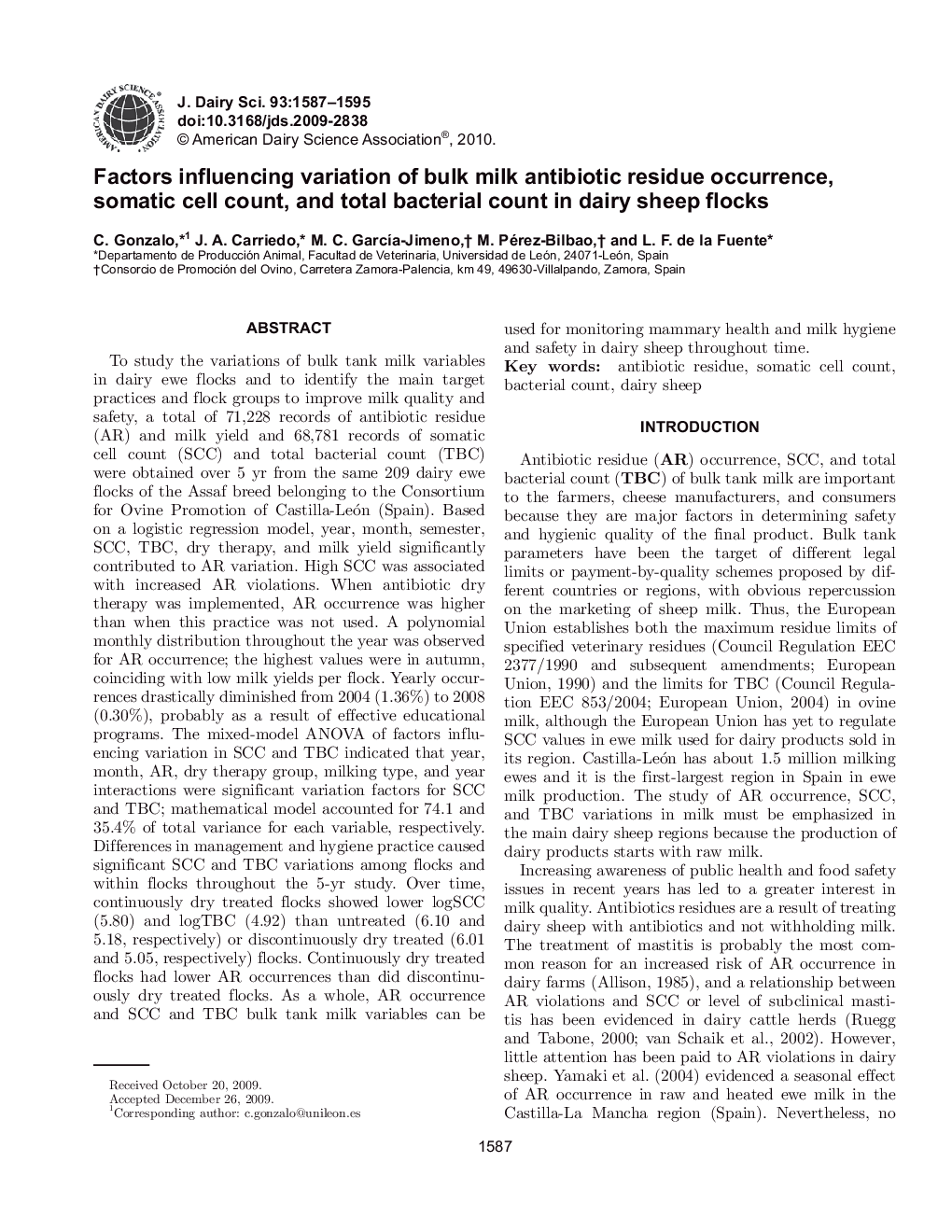| کد مقاله | کد نشریه | سال انتشار | مقاله انگلیسی | نسخه تمام متن |
|---|---|---|---|---|
| 10982434 | 1108097 | 2010 | 9 صفحه PDF | دانلود رایگان |
عنوان انگلیسی مقاله ISI
Factors influencing variation of bulk milk antibiotic residue occurrence, somatic cell count, and total bacterial count in dairy sheep flocks
دانلود مقاله + سفارش ترجمه
دانلود مقاله ISI انگلیسی
رایگان برای ایرانیان
کلمات کلیدی
موضوعات مرتبط
علوم زیستی و بیوفناوری
علوم کشاورزی و بیولوژیک
علوم دامی و جانورشناسی
پیش نمایش صفحه اول مقاله

چکیده انگلیسی
To study the variations of bulk tank milk variables in dairy ewe flocks and to identify the main target practices and flock groups to improve milk quality and safety, a total of 71,228 records of antibiotic residue (AR) and milk yield and 68,781 records of somatic cell count (SCC) and total bacterial count (TBC) were obtained over 5 yr from the same 209 dairy ewe flocks of the Assaf breed belonging to the Consortium for Ovine Promotion of Castilla-León (Spain). Based on a logistic regression model, year, month, semester, SCC, TBC, dry therapy, and milk yield significantly contributed to AR variation. High SCC was associated with increased AR violations. When antibiotic dry therapy was implemented, AR occurrence was higher than when this practice was not used. A polynomial monthly distribution throughout the year was observed for AR occurrence; the highest values were in autumn, coinciding with low milk yields per flock. Yearly occurrences drastically diminished from 2004 (1.36%) to 2008 (0.30%), probably as a result of effective educational programs. The mixed-model ANOVA of factors influencing variation in SCC and TBC indicated that year, month, AR, dry therapy group, milking type, and year interactions were significant variation factors for SCC and TBC; mathematical model accounted for 74.1 and 35.4% of total variance for each variable, respectively. Differences in management and hygiene practice caused significant SCC and TBC variations among flocks and within flocks throughout the 5-yr study. Over time, continuously dry treated flocks showed lower logSCC (5.80) and logTBC (4.92) than untreated (6.10 and 5.18, respectively) or discontinuously dry treated (6.01 and 5.05, respectively) flocks. Continuously dry treated flocks had lower AR occurrences than did discontinuously dry treated flocks. As a whole, AR occurrence and SCC and TBC bulk tank milk variables can be used for monitoring mammary health and milk hygiene and safety in dairy sheep throughout time.
ناشر
Database: Elsevier - ScienceDirect (ساینس دایرکت)
Journal: Journal of Dairy Science - Volume 93, Issue 4, April 2010, Pages 1587-1595
Journal: Journal of Dairy Science - Volume 93, Issue 4, April 2010, Pages 1587-1595
نویسندگان
C. Gonzalo, J.A. Carriedo, M.C. GarcÃa-Jimeno, M. Pérez-Bilbao, L.F. de la Fuente,